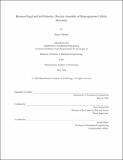| dc.contributor.author | Ochalek, Megan
(Megan E.) | en_US |
| dc.contributor.other | Massachusetts Institute of Technology. Department of Mechanical Engineering. | en_US |
| dc.date.accessioned | 2022-10-12T14:59:23Z | |
| dc.date.available | 2022-10-12T14:59:23Z | |
| dc.date.copyright | 2020 | en_US |
| dc.date.issued | 2020 | en_US |
| dc.identifier.uri | https://hdl.handle.net/1721.1/145791 | |
| dc.description | Thesis: S.B., Massachusetts Institute of Technology, Department of Mechanical Engineering, May, 2020 | en_US |
| dc.description | Cataloged from student-submitted PDF of thesis. | en_US |
| dc.description | Includes bibliographical references (pages 36-37). | en_US |
| dc.description.abstract | Traditional robots consist of rigid links and joints to create mechanisms, end effectors, and limbs. Soft robotics is a subfield of robotics which utilizes highly compliant materials to create bio-inspired movement. The field is of high interest at the moment, as it presents new opportunities for adapting and navigating in environments difficult for conventional robotics. Despite these benefits, soft robotics still has some limitations due to the inherent manufacturing challenges of polymeric and elastomeric materials. A recent approach based on discrete assembly of modular lattice components shows promise for scalable construction of tunable material systems. This thesis proposes the use of a tool kit of components to discretely assemble lightweight, cellular structures with spatially programmable anisotropy. This bridges the gap between soft and hard robotics, allowing robots to exhibit both soft and hard characteristics. Starting at the basic building block, this thesis will describe going from 0D to 1D to 2D to 3D structures. Two part types - rigid and compliant - will be used to tune spatial heterogeneity. As a simple case study, I will take an anisotropic beam, and show how analytical, numerical, and experimental characterizations compare. Then, I will study how actuation can be used to provide shape authority over the beam, and compare numerical results with experiments. Through this, I can extract performance metrics relating mass, stiffness, strength, energy, and deflection. From here, leveraging the inherent modularity and hierarchical scaling of discrete lattice systems, I can project performance for larger scale morphing structures, thereby describing a method to combine soft and hard robotics. | en_US |
| dc.description.statementofresponsibility | by Megan Ochalek. | en_US |
| dc.format.extent | 37 pages | en_US |
| dc.language.iso | eng | en_US |
| dc.publisher | Massachusetts Institute of Technology | en_US |
| dc.rights | MIT theses may be protected by copyright. Please reuse MIT thesis content according to the MIT Libraries Permissions Policy, which is available through the URL provided. | en_US |
| dc.rights.uri | http://dspace.mit.edu/handle/1721.1/7582 | en_US |
| dc.subject | Mechanical Engineering. | en_US |
| dc.title | Between rigid and soft robotics : discrete assembly of heterogeneous cellular structures | en_US |
| dc.type | Thesis | en_US |
| dc.description.degree | S.B. | en_US |
| dc.contributor.department | Massachusetts Institute of Technology. Department of Mechanical Engineering | en_US |
| dc.identifier.oclc | 1241688644 | en_US |
| dc.description.collection | S.B. Massachusetts Institute of Technology, Department of Mechanical Engineering | en_US |
| dspace.imported | 2022-10-12T14:59:23Z | en_US |
| mit.thesis.degree | Bachelor | en_US |
